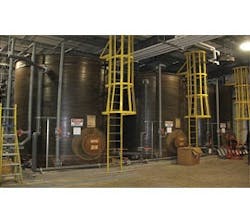About the author: Abigail Antolovich is strategic marketing manager for UOP, a Honeywell Co. Antolovich can be reached at [email protected] or 847.224.5739.
In the late 1990s, a coking facility in Detroit closed, and the site was subjected to strict cleanup requirements as part of new government regulations. As part of the overall site cleanup activities, the facility was required to capture groundwater contaminated with creosote oil, aromatic hydrocarbons, ammonia and iron, and prevent it from migrating off-site and potentially contaminating surrounding areas. The final destination for the groundwater was a municipal wastewater treatment plant. More stringent limits on organic and nitrogen discharges into the municipal wastewater treatment plant drove treatment goals at the facility. The primary treatment targets for this application were to reduce the priority pollutants to less than 5 parts per billion and to reduce ammonia to less than 5 parts per million (ppm).
Selecting a Solution
Activated carbon was identified as a treatment option for the groundwater treatment process. The presence of iron in the groundwater, however, created unique challenges for applying activated carbon because iron inhibits adsorption of other organics due to fouling of the carbon surface. Without additional resin amendments, activated carbon would not be capable of removing the organics and ammonia from the groundwater; therefore, a solution was required that would effectively remove the target contaminants in the presence of competing contaminants.
UOP’s XCeed bioreactor, with a maximum treatment capacity of 100 gal per minute, was selected to remove organics and ammonia to help meet discharge requirements. The system, combined with an upstream oil and water separator and downstream activated carbon polishing, provided a complete solution for the site to remove creosote oil contaminants from the groundwater. Figure 1 depicts the full groundwater treatment process for meeting cleanup goals at the site.
Treatment Technology
The bioreactor is an advanced biological treatment process for bulk removal of organic and inorganic contaminants, making it ideally suited for groundwater remediation applications. The system’s compartmentalized plug-flow design and high solids retention time lead to highly efficient treatment with low sludge generation, low operational and maintenance costs, and low component replacement costs.
The system is based on Honeywell’s immobilized cell bioreactor (ICB) technology. Using a biological ecosystem with more complex generations of microbial growth, the bioreactor enables a longer biomass retention time of close to 100 days.
The long retention time of biomass in the bioreactor promotes the growth of protozoa, nematodes, rotifers and oligochaeta that reduce biomass production by predation of the primary trophic microorganisms. These processes result in low sludge yields.
An additional benefit of the long retention time is performance stability. The long retention time promotes a high concentration of biomass with a stable population. The nature of the microbial population results in resistance to upstream process changes and allows for the bioreactor to reach a steady state quickly after a restart—typically within two days.
The compartmentalized design of the bioreactor system promotes the efficient removal of recalcitrant contaminants. Water flows through the bioreactor, cascading from one section to another via hydraulic head. This compartmentalization simulates quasi plug-flow characteristics in the system, promoting high removal efficiency in a compact reactor. Compartmentalization also promotes spatial separation of specific metabolic processes such as organics removal and nitrification. The absence of mechanical equipment in the design minimizes energy consumption and reduces overall process complexity.
Results from full-scale installations have been demonstrated to reduce concentrations of organic and inorganic contaminants by up to 98%, helping a wide variety of industrial manufacturers meet regulatory requirements and internal standards for quality, reuse or other processing operations. Typical operating parameters are as follows:
- • Mixed liquor suspended solids: 7,000 to 10,000 ppm
- • Biomass retention time: Approximately 100 days
- • Sludge yield: Approximately 0.08 kg biomass per kilogram of biological oxygen demand (BOD) consumed
- • Biomass loading: Up to 10 kg biochemical oxygen demand per cubic meter per day
- • Energy consumption: Approximately 0.1 kW per hour per kilogram BOD removed
The bioreactor can be delivered as a packaged plant or retrofitted into existing basins. Each system is designed and installed based on site-specific requirements and incorporated into the overall treatment train to provide a total solution that meets water quality goals.
Successful Contaminant Removal
The bioreactor system at the Detroit facility reduced aromatic organic contaminants to below the level of analytical detection. The system also reduced ammonia concentrations from nearly 18 mg/L to about 7 µg/L and iron concentrations from approximately 10 mg/L to 97 µg/L. Table 1 demonstrates the significant reduction in target contaminants via treatment with the XCeed system.
The bioreactor also reduced dissolved iron by oxidizing dissolved ferrous iron to insoluble ferric hydroxide. This iron sludge is periodically removed from the bioreactor. After seven years of continuous operation, the activated carbon polisher has not yet required replacement. The system has reduced both the organic load and the iron in the influent to the carbon tower by more than 99%. It has consistently met treatment goals and facilitated efficient operation of the downstream polishing step.
Contaminant removal solutions have been applied successfully to remove impurities such as radionuclides, heavy metals and organics from various waste and groundwater streams. Bioreactor technology has proven successful in food and beverage, chemical and textile manufacturing, groundwater remediation, and refinery and petrochemical applications worldwide. The system at the coking facility in Detroit helped the operator meet regulatory requirements for wastewater discharge.
Download: Here
